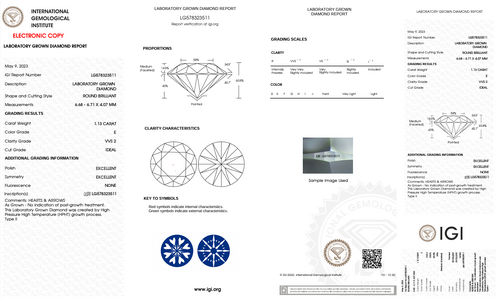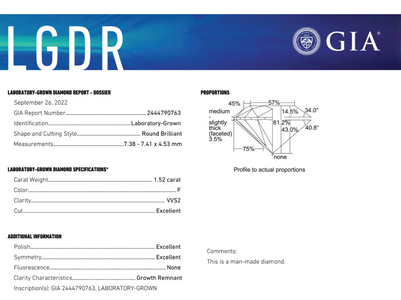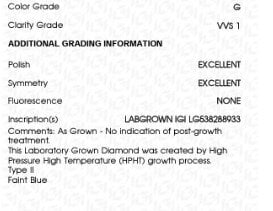- Joined
- Jul 27, 2009
- Messages
- 4,097
Until relatively recently, if you polled American diamond shoppers, 9 out of 10 would probably have told you they prefer a diamond report from GIA (Gemological Institute of America) over IGI (International Gemological Institute). Not that IGI wasn’t already a force – they were - and had already established a solid reputation in the market. But because the GIA literally invented the diamond grading process and has such a dominant presence in the single biggest market in the world, American buyers came to trust GIA as the foremost authority on diamonds, and the most accurate and reliable source of diamond grading. Diamond shoppers in the US and abroad generally demanded a GIA report on any diamond of significant value, considering GIA to be the ultimate arbiter of diamond quality.
But that all started to change when laboratory grown diamonds (LGD) started coming onto the market in large volume. GIA was hesitant at first to be seen as “endorsing” lab grown diamonds and were accordingly somewhat passive in trying to gain market share for issuing reports on them. IGI took the opposite approach, aggressively seeking to fill a surging demand for reports on LGD. As a result they quickly became the industry leader in this emerging field, thereby introducing IGI to a whole new generation of diamond shoppers. A very smart play!
The IGI Advantage
If you are buying a laboratory grown diamond today, an IGI report is arguably a better all-around value than a GIA report. There are several contributing reasons for this.

The Cut Quality Movement
There are other reasons that many consumers have reason to embrace IGI reports. With cut quality a key factor in the decision-making process of today’s consumer, IGI provides some cut info that GIA does not. In addition to their incorporation of IdealScope into their version of light performance grading, it is also possible to get a hearts and arrows designation on an IGI report. This is an indication that a round diamond has a high level of 3-dimensional facet precision, also known as optical symmetry. This is not only an indication of careful craftsmanship, but a precision cut diamond will enable the full expression of the facet design. *It’s important to note that there may still be some performance deficits in a hearts and arrows diamond due to proportioning or transparency issues.
IGI is also now offering cut grading on fancy shape diamonds. This was rolled out in 2022 and has so far not attracted as many adherents in the manufacturing world. And since it is an optional feature on an IGI report not every fancy shape diamond graded by IGI comes with an overall cut grade. But presumably they will in time.
Overall, IGI is having its big moment in the sun thanks to the surge in lab grown diamonds in the market. And they seem to be taking full advantage of it and adding positively to their brand awareness. Having managed their growth while adding new features and maintaining a solid reputation in the market, there will undoubtedly be a positive carryover effect for IGI with regard to reporting on natural diamonds. In fact, that seems to already be happening online as more consumers are considering natural diamonds of some significance with IGI reports.
GIA is NOT Standing Pat
GIA may be a large and conservative organization that proceeds very deliberately (translated: slooowly), but they are clearly not satisfied with maintaining the status quo. It took them a long while to finally add an overall cut grade to reports for round diamonds. The American Gem Society Laboratories (AGSL) beat them to that punch by 10 years, and actually came out with their revolutionary light performance grading system about the same time as the GIA released their broad and forgiving parametric system, thereby leapfrogging them once again. But GIA recently made the bold and strategic move of acquiring that technology from AGS and every indication points to their intention to use it to improve and expand their cut grading services. Though they had never put an overall cut grade on a report for a fancy shape diamond before this, GIA now offers an AGS Ideal report on any diamond that qualifies as AGS 0, including fancy shapes.
The next step would be for them to roll out cut grading for fancies that do not meet that exceptionally high standard. Consumers do want this information, even if the stone they choose is not Ideal cut. The acquisition of AGSL light performance grading technology has given GIA the tools to finally meet the market demand for overall cut grading of fancy shapes. And indications are that they intent to do just that. So, don’t count the GIA out; although they are playing catch-up again in the cut grade space, their reach and reputation give them a platform to quickly retake a leading position in cut grading globally.
IGI’s Rising Star – Will it Continue to Shine?
IGI is a great organization and they have been moving apace to expand and add features and benefits to their reports. Lab grown diamonds have given them a rocket fueled boost and they have taken full advantage. It could be that lab grown diamonds will eventually be marketed without laboratory reports. The product may soon be sold primarily with grading descriptions provided by the vendor. If so, this would amount to a significant loss of revenue for IGI, and it will be important for them to continue to grow their market for natural diamonds in order to stay on the current trajectory. Only time will tell how that plays out, but right now IGI is cooking!
So what are your thoughts? The Pricescope community is never shy about opinions on lab grading of diamonds!
But that all started to change when laboratory grown diamonds (LGD) started coming onto the market in large volume. GIA was hesitant at first to be seen as “endorsing” lab grown diamonds and were accordingly somewhat passive in trying to gain market share for issuing reports on them. IGI took the opposite approach, aggressively seeking to fill a surging demand for reports on LGD. As a result they quickly became the industry leader in this emerging field, thereby introducing IGI to a whole new generation of diamond shoppers. A very smart play!
The IGI Advantage
If you are buying a laboratory grown diamond today, an IGI report is arguably a better all-around value than a GIA report. There are several contributing reasons for this.
- Cost - the higher cost of a GIA report combined with the lower prices of LGD make IGI reports more economically viable for manufacturers in a hyper-competitive marketplace.
- More info - IGI reports contain more info of interest to LGD buyers than the most popular GIA report (LGDR- Dossier), including diamond type and growth method.
- Color/Clarity grades have less impact - LGD is a technology product with ample material available in the upper color and clarity ranges in ever larger sizes and increasingly affordable prices. Compared to high priced natural diamonds whose values are predicated on rarity, there is relatively little at stake in a grade or two with LGDs. Thus, even if IGI grading is a bit “softer” than GIA (as some believe) it does not have a significant impact on the value of an LGD.
-


IGI Report “AS Grown” with Hearts and Arrows Designation
The Cut Quality Movement
There are other reasons that many consumers have reason to embrace IGI reports. With cut quality a key factor in the decision-making process of today’s consumer, IGI provides some cut info that GIA does not. In addition to their incorporation of IdealScope into their version of light performance grading, it is also possible to get a hearts and arrows designation on an IGI report. This is an indication that a round diamond has a high level of 3-dimensional facet precision, also known as optical symmetry. This is not only an indication of careful craftsmanship, but a precision cut diamond will enable the full expression of the facet design. *It’s important to note that there may still be some performance deficits in a hearts and arrows diamond due to proportioning or transparency issues.
IGI is also now offering cut grading on fancy shape diamonds. This was rolled out in 2022 and has so far not attracted as many adherents in the manufacturing world. And since it is an optional feature on an IGI report not every fancy shape diamond graded by IGI comes with an overall cut grade. But presumably they will in time.
Overall, IGI is having its big moment in the sun thanks to the surge in lab grown diamonds in the market. And they seem to be taking full advantage of it and adding positively to their brand awareness. Having managed their growth while adding new features and maintaining a solid reputation in the market, there will undoubtedly be a positive carryover effect for IGI with regard to reporting on natural diamonds. In fact, that seems to already be happening online as more consumers are considering natural diamonds of some significance with IGI reports.
GIA is NOT Standing Pat
GIA may be a large and conservative organization that proceeds very deliberately (translated: slooowly), but they are clearly not satisfied with maintaining the status quo. It took them a long while to finally add an overall cut grade to reports for round diamonds. The American Gem Society Laboratories (AGSL) beat them to that punch by 10 years, and actually came out with their revolutionary light performance grading system about the same time as the GIA released their broad and forgiving parametric system, thereby leapfrogging them once again. But GIA recently made the bold and strategic move of acquiring that technology from AGS and every indication points to their intention to use it to improve and expand their cut grading services. Though they had never put an overall cut grade on a report for a fancy shape diamond before this, GIA now offers an AGS Ideal report on any diamond that qualifies as AGS 0, including fancy shapes.
The next step would be for them to roll out cut grading for fancies that do not meet that exceptionally high standard. Consumers do want this information, even if the stone they choose is not Ideal cut. The acquisition of AGSL light performance grading technology has given GIA the tools to finally meet the market demand for overall cut grading of fancy shapes. And indications are that they intent to do just that. So, don’t count the GIA out; although they are playing catch-up again in the cut grade space, their reach and reputation give them a platform to quickly retake a leading position in cut grading globally.
IGI’s Rising Star – Will it Continue to Shine?
IGI is a great organization and they have been moving apace to expand and add features and benefits to their reports. Lab grown diamonds have given them a rocket fueled boost and they have taken full advantage. It could be that lab grown diamonds will eventually be marketed without laboratory reports. The product may soon be sold primarily with grading descriptions provided by the vendor. If so, this would amount to a significant loss of revenue for IGI, and it will be important for them to continue to grow their market for natural diamonds in order to stay on the current trajectory. Only time will tell how that plays out, but right now IGI is cooking!
So what are your thoughts? The Pricescope community is never shy about opinions on lab grading of diamonds!









300x240.png)